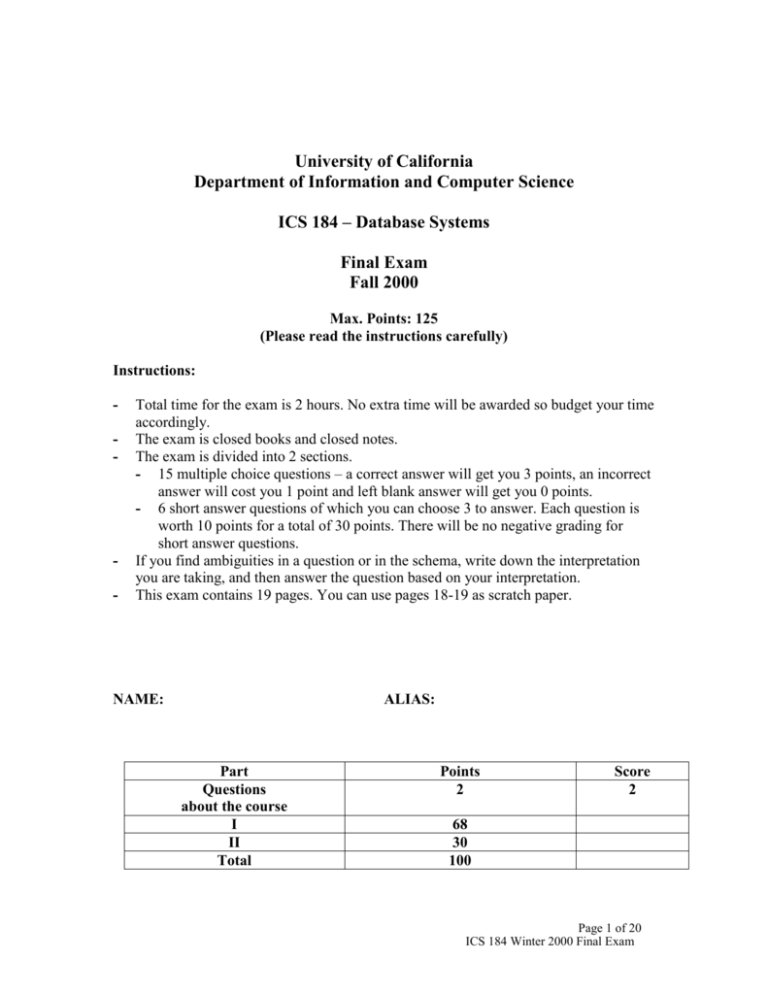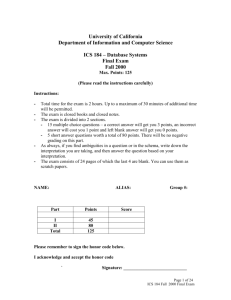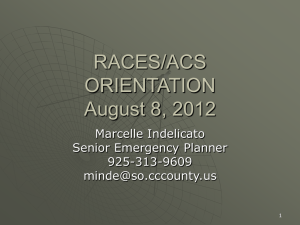Solution
advertisement

University of California
Department of Information and Computer Science
ICS 184 – Database Systems
Final Exam
Fall 2000
Max. Points: 125
(Please read the instructions carefully)
Instructions:
-
-
Total time for the exam is 2 hours. No extra time will be awarded so budget your time
accordingly.
The exam is closed books and closed notes.
The exam is divided into 2 sections.
- 15 multiple choice questions – a correct answer will get you 3 points, an incorrect
answer will cost you 1 point and left blank answer will get you 0 points.
- 6 short answer questions of which you can choose 3 to answer. Each question is
worth 10 points for a total of 30 points. There will be no negative grading for
short answer questions.
If you find ambiguities in a question or in the schema, write down the interpretation
you are taking, and then answer the question based on your interpretation.
This exam contains 19 pages. You can use pages 18-19 as scratch paper.
NAME:
ALIAS:
Part
Questions
about the course
I
II
Total
Points
2
Score
2
68
30
100
Page 1 of 20
ICS 184 Winter 2000 Final Exam
Question 1:
Consider a relation R(A,B,C,D,E) with the following functional dependencies:
ABC DE and
D AB.
The number of superkeys of R is:
(a) 2
(b) 7
(c) 10
*****
(d) 12
Question 2: Consider the following E/R diagram:
C
A
B
R
D
Below are three possible relationship sets for this E/R diagram:
I.
A
a1
a1
B
b1
b1
C
c1
c1
D
d1
d2
II.
A
a1
a1
B
b1
b1
C
c1
c2
D
d1
d2
A
B
C
D
Page 2 of 20
ICS 184 Winter 2000 Final Exam
III.
a1 b1 c1 d1
a1 b2 c1 d1
You may assume that different symbols stand for different values, e.g., d1 is definitely not
equal to d2. Which of the above could not be the relationship set for the E/R diagram?
(a) I only
*****
(b) I and II only
(c) II only
(d) I, II and III.
Question 3: One of the following four expressions of relational algebra is not equivalent
to the other three. They are all based on the relations R(A,B) and S(B,C). Indicate which is
not equivalent to the others.
(a) AB (R ⋈ S)
(b) R ⋈ B(S)
(c) R (A(R) x B(S))
(d) A,R.B(R x S)
*******
Question 4: Of the following three equivalence’s between expressions of relational
algebra, each involving relations R(A,B) and S(C,D) (note the schema of S is different
from that of the question above), which is true?
(a) A,B(R x S) = R
(b) R - T(A,B)(S) = T(A,B)(S - U(C,D)(R))
(c) A,B,D(R ⋈ S) = R ⋈ T(B,D) (S)
B=C
********
(d) none of the above (i.e., they are all false)
Page 3 of 20
ICS 184 Winter 2000 Final Exam
Question 5: Below is an E/R Diagram:
A
R
S
B
C
Indicate which of the ODL specifications best mimics the intent of this E/R diagram. In
both E/R and ODL, we have omitted mention of all attributes, which you may thus
ignore.
(a) Interface A {relation
Interface B {relation
relation
Interface C {relation
(b)
Interface A {relation
Interface B {relation
relation
Interface C {relation
Set<B>
Set<A>
Set<C>
Set<B>
R
R
S
R
inverse
inverse
inverse
inverse
B::R;};
A::R;};
C::S;};
B::S;};
B R inverse B::R;};
Set<A> R inverse A::R;};
C S inverse C::S;};
Set<B> S inverse B::S;};
************
(c)Interface A {relation set <B> R inverse B::R;};
Interface B {relation A R inverse A::R;};
relation Set<C> S inverse C::S;};
Interface C {relation B S inverse B::S;};
(d)
Interface A {relation
Interface B {relation
relation
Interface C {relation
B
A
C
B
R
R
S
S
inverse
inverse
inverse
inverse
B::R;};
A::R;};
C::S;};
B::S;};
Page 4 of 20
ICS 184 Winter 2000 Final Exam
The following 4 questions are based on a relation
Emps(empID, ssNo, name, mgrID)
giving for a set of employees their employee ID (assumed unique), their social-security
number (also unique), the name of the employee (not necessarily unique, and the
employee ID of the manager of the employee. Assume that the president is his/her own
manager, so every employee has a unique manager. You may assume there are no
duplicate tuples in this relation.
Question 6: Here are two possible ways to declare the relation Emps.
I.
CREATE TABLE Emps (
empID INT,
ssNo INT,
name CHAR(50),
mgrID INT,
UNIQUE (empID),
PRIMARY KEY (ssNo),
FOREIGN KEY mgrID REFERENECES Emps (empID)
);
II.
CREATE TABLE Emps (
empID INT PRIMARY KEY,
ssNo INT UNIQUE,
name CHAR(50),
mgrID INT REFERENECES Emps (empID)
);
Which, if any, of the two declarations above will correctly (in SQL2) declare the relation
Emps?
(a) Both I and II
(b) I only
(c) II only
******************
(d) Neither I nor II
Question 7: Suppose we wish to find the ID’s of the employees that are managed by
people who are managed by the employee with ID 123. Here are two possible queries:
I.
SELECT ee.empID
FROM Emps ee, Emps ff
WHERE ee.mgrID = ff.empID AND ff.mgrID = 123;
II.
SELECT empID
FROM Emps
WHERE mgrID IN
(SELECT empID FROM Emps WHERE mgrID = 123);
Page 5 of 20
ICS 184 Winter 2000 Final Exam
Which, if any, of the two queries above will correctly (in SQL2) get the desired set of
employee ID’s?
(a) Both I and II
***********
(b) I only
(c) II only
(d) Neither I nor II
Question 8: Suppose we wish to find the ID’s of the employees who do not manage any
employee named “Sally.” Here are two possible queries:
I.
SELECT mgrID
FROM Emps
WHERE NOT EXISTS(SELECT * FROM Emps WHERE NAME = ‘Sally’);
II.
SELECT mgrID
FROM Emps
WHERE NOT (empID = ANY(SELECT EmpID FROM Emps WHERE name =
‘Sally’));
Which, if any, of the two queries above will correctly (in SQL2) get the desired set of
employee ID’s?
(a) Both I and II
(b) I only
(c) II only
(d) Neither I nor II
**********
Question 9: We wish to assert that no one can manage more than 10 employees. Here are
two possible SQL2 assertions:
I.
CREATE ASSERTION I CHECK(NOT EXISTS(
SELECT mgrID
FROM Emps
GROUP BY mgrID
HAVING COUNT(*) > 10
));
II.
CREATE VIEW mgrCounts AS
SELECT mgrID, COUNT(*) AS cnt FROM Emps GROUP BY mgrID;
CREATE ASSERTION II CHECK(10 >=
(SELECT MAX(cnt) FROM mgrCounts);
Page 6 of 20
ICS 184 Winter 2000 Final Exam
Which, if any, of the two queries above will correctly (in SQL2) get the desired set of
employee ID’s?
(a) Both I and II
*********
(b) I only
(c) II only
(d) Neither I nor II
Question 10:
Consider the following relation:
Family(parent, child, childDOB)
The intent is that a tuple (p,c,d) means that parent p has child c, who was born on date d.
You may assume that parents do not have two children of the same name, and that there
are no twins; i.e., no parent has two or more children born on the same day. Here are
three queries we might ask about this data:
I.
Find for each parent, the youngest child, i.e., the set of (p,c) such that p has child
c, and no other child of p has a smaller date of birth than c does.
II.
Find the set of great grandparents of “Amy.”
III.
Find all the descendants of “Mike.”
Which of the above queries are expressible in relational algebra?
(a) I only.
(b) I and II only.
********
(c) III only.
(d) I, II and III.
Page 7 of 20
ICS 184 Winter 2000 Final Exam
Question 11:
Suppose relation R(A,B) currently has tuples {(1,2), (1,3), (3,4)} and relation S(B,C)
currently has {(2,5), (4,6), (7,8)}. Then the number of tuples in the result of the SQL
query:
Select *
From R Natural Outer Join S;
is:
(a) 2
(b) 4 *******
(c) 6
(d) non of the above
Question 12:
If , , are given their bag interpretations, which of the following laws hold?
(a)
(b)
(c)
(d)
RR=R
R (S T) = (R S) (R T)
R (S T) = (R S) T
None of the above ********
Question 13:
Suppose relation R(A,B,C,D,E) has the following functional dependencies:
AB
BC
BC A
AD
EA
DE
Which of the following is not a key?
(a) A
(b) E
(c) B,C
*********
(d) D
Page 8 of 20
ICS 184 Winter 2000 Final Exam
Question 14:
Consider the following SQL query on the relation R(A,B) that has no NULL's.
Select rr.A, rr.B,ss.A, ss.B
From R as rr, R as ss
Where rr.A = ss.A and rr.B = ss.B
Suppose that R has n tuples (not necessarily all distinct). Which of the above conditions is
the most restrictive correct limitation on m, the number of tuples (again not necessarily
all distinct) in the result?
(a) n m n*n
********
(b) n m 2n
(c) 0 m n
(d) m = n
Question 15:
Suppose now that R(A,B) and S(A,B) are two relations with r and s tuples, respectively
(again, not necessarily distinct). If m is the number of (not necessarily distinct) tuples in
the result of the SQL query:
R intersect S;
Then which of the following is the most restrictive, correct condition on the value of m?
(a) m = min(r,s)
(b) 0 m r + s
(c) min(r,s) m max(r,s)
(d) 0 m min(r,s)
************
Page 9 of 20
ICS 184 Winter 2000 Final Exam
Question 16: (24 Points)
In this and the following questions you shall write queries in SQL and relational algebra
over the following example database:
Beer(name, manf)
Bars(name, addr, license)
Drinkers(name, addr, phone)
Likes(drinker, beer)
Sells(bar, beer, price)
Frequents(drinker, bar)
This question is devoted to SQL queries, database modifications, and declarations. Write
the following in standard SQL2, being as succinct as possible.
a) Find the name and address of all drinkers who frequent Joe's Bar and like some Beer
that Joe's Bar sells. Do not print any drinker more than once.
SELECT DISTINCT D.name, D.addr
FROM Drinkers AS D, Frequents AS F, Likes AS L, Sells AS S
WHERE D.name = L.drinker AND
D.name = F.drinker AND
S.beer = L.beer AND
S.bar = F.bar AND
S.bar = 'Joe''s Bar'
a more succinct query would look like
SELECT DISTINCT D.name, D.addr
FROM Drinkers AS D,
((Frequents NATURAL JOIN Likes) NATURAL JOIN Sells) AS F
WHERE D.name = F.drinker AND
F.bar = 'Joe''s Bar'
b) Delete from Drinkers table all drinkers in the 949 area code. You may assume that
phone numbers are represented by character strings of the form '(xxx) yyy-zzzz',
where xxx corresponds to the area code.
DELETE FROM Drinkers
WHERE phone LIKE '(650) ___-____'
phone LIKE '(650)%' also got full credit
Page 10 of 20
ICS 184 Winter 2000 Final Exam
c) Find for each price (that appears in Sells) the number of bars that serve at least one
beer at that price.
SELECT price, COUNT(DISTINCT bar)
FROM Sells
GROUPBY price
B: Using SELECT in the FROM clause -2
C: Not using DISTINCT -1
D: Unnecessary join with an irrelevant relation -2
d) Declare an assertion that says no drinker can frequent a bar with the same address as
the drinker.
CREATE ASSERTION DoesnotDrinkAtHome CHECK
(NOT EXISTS
(SELECT *
FROM Drinkers AS D, Frequents AS F, Bars AS B
WHERE D.name = F.drinker AND
F.bar = B.name AND
D.addr = B.addr))
Page 11 of 20
ICS 184 Winter 2000 Final Exam
e) Write a declaration of the Bars relation, including the fact that name is a key, the
default address is 'unknown', and the license value can only be one of the strings 'beer'
and 'full'. Use appropriate data types for the attributes.
CREATE TABLE Bars (
name VARCHAR(20) PRIMARY KEY,
addr VARCHAR(127) DEFAULT 'who knows?',
license CHAR(4) CHECK (licence IN ('full', 'beer'))
)
B: Using something other than CHAR(4) for license -1
C: Not marking PRIMARY KEY or UNIQUE -2
D: Not putting the constraint for license -2
f) Insert into Bars (with default values for address and license) all those bars that are
mentioned in Frequents but not in Bars.
INSERT INTO Bars(name)
SELECT DISTINCT bar
FROM Frequents
WHERE bar NOT IN (SELECT name FROM Bars)
B: Not using DISTINCT for bar -1
C: Adding own default values -1
Page 12 of 20
ICS 184 Winter 2000 Final Exam
Question 17: (20 Points)
Using the same beer schema as in Problem above:
Beer(name, manf)
Bars(name, addr, license)
Drinkers(name, addr, phone)
Likes(drinker, beer)
Sells(bar, beer, price)
Frequents(drinker, bar)
Write the following in relational algebra. You may, if you wish, break complex
expressions into steps by defining temporary relations.
a) Find all pairs of drinkers (i.e., their names) that have the same address. Produce the
pair in only one order; e.g., if you produce (a,b), do not also produce (b,a). (4 points)
D1(name1, addr, phone1) := Drinkers(name, addr, phone) <BR>
D2(name2, addr, phone2) := Drinkers(name, addr, phone) <BR>
Ans(name1, name2) := SIGMA_{name1&lt;name2}(D1 JOIN D2)
b) Find all the bars mentioned in both Sells and Frequents, but not in Bars. (4 points)
BBars(bar) := PI_{name}(Bars) <BR>
Ans(bar) := PI_{bar}(Frequents) INTERSECT PI_{bar}(Sells) - BBars
Page 13 of 20
ICS 184 Winter 2000 Final Exam
c) Find all the bars that serve only beers that drinker "Sally" likes. (4 points)
SallyLikes(beer) := PI_{beer}(SIGMA_{drinker = 'Sally'}(Beers JOIN
Likes))
NotSallyLikes(beer) := PI_{beer}(Sells) - SallyLikes
Ans(bar) := PI_{bar}(Sells) - PI_{bar}(Sells JOIN NotSallyLikes)
d) Find the drinkers that frequent no bar that serves a beer that they like. (8 points)
A= PI_{drinker} ( Likes (NATURAL JOIN ) Sells (NATURAL JOIN) Frequents )
Answer= PI_{drinker} (Frequents) - A
Page 14 of 20
ICS 184 Winter 2000 Final Exam
Question 18: (10 Points)
Consider the simple relation Employee(ID, salary) storing the employee Ids and salaries,
where ID is a key. Consider the following two triggers over this relation:
create trigger T1
after insert on Employee
referencing new as New_Emp
update Employee
set salary = 1.1 * (select max(salary) from Employee)
where ID = New_Emp.ID
for each row
create trigger T2
after insert on Employee
referencing newtable as New_Emp
update Employee
set salary = 1.1 * (select max(salary) from Employee)
where ID in (select ID from New_Emp)
for each statement
Assume that relation Employee has no tuples in it initially. You are to show the simplest
example you can think of where using trigger T1 will produce a different final database
state than using trigger T2.
a) Show a sequence of inserted tuples. For purposes of the example, assume that all
tuples are inserted as the result of the single SQL statement. (2 points)
Lets say we had inserted the following four rows into the Employee table :
1
2
3
4
1000
2000
3000
4000
Page 15 of 20
ICS 184 Winter 2000 Final Exam
b) Show the final database state after trigger execution if only trigger T1 is defined. (4
points)
In case of Trigger 1 , since the trigger operates after every row insert operation we get
the following state:
For T1 execution final state of Employee :
1
2
3
4
1100
2200
3300
4400
c) Show the final database state after trigger execution if only trigger T2 is defined. (4
points)
Trigger2 executes after all the insert statements have been executed , and the final state
of the Employee table is :
1
2
3
4
4400
4400
4400
4400
Page 16 of 20
ICS 184 Winter 2000 Final Exam
Page 17 of 20
ICS 184 Winter 2000 Final Exam
Question 19: (8 points)
Consider the following SQL declarations:
Create table Employee (ID integer unique, salary integer,
dept# integer)
Create table Department (number integer unique, salaryCap
integer)
Create assertion Policy check(
Not exists (select *
From Employee, Department
Where Employee.dept# = Department.number
And Employee.salary > Department.salaryCap))
a) State in English the policy enforced by the assertion Policy. (3 points)
The above trigger states that after any insertion or update on the Employee or the
Department table, there should not be any employee having a salary greater than the
salary Cap in the corresponding department of the employee.
b) Rewrite the above table declarations to use relation-based check constraints instead of
the general assertion. Your constraints should be defined so that under no
circumstances can the policy be violated. Remember you will be graded for simplicity
as well as correctness. (5 points)
In the employee table define the following tuple based check constraint:
CHECK ( salary < (Select salaryCap from Department
where Department.number=dept#) )
In the department table add the following check constraint :
CHECK ( salaryCap > ALL (Select salary from Employee
where Employee.dept#=number) )
Page 18 of 20
ICS 184 Winter 2000 Final Exam
Question 20: (10 points)
Suppose relation R(A,B,C,D,E) has functional dependencies:
AB C
DA
AE B
CD E
BE D
Find all the candidate keys of R.
CD -> E
CD -> D -> A
CD -> A
CD ->ACDE
This implies CD -> AE ->B
Thus CD -> ABCDE
CD is a candidate key
BE -> D -> A
BE -> AD
BE ->ABDE
Since AB -> C and BE -> AB
Thus BE -> C
BE -> ABCDE
BE is a candidate key .
AE -> B
AE -> BE
AE -> D since BE -> D
AE -> ABDE
AE -> C since AE-> AB and AB ->C
AE -> ABCDE
Page 19 of 20
ICS 184 Winter 2000 Final Exam
Thus AE is also a candidate key
D -> A
BD -> AB
BD -> C since AB -> C
BD -> ABCD
BD -> E since BD -> CD and CD ->E
BD -> ABCDE
Thus BD is a candidate key
similarly DE is also a candidate key ..
Page 20 of 20
ICS 184 Winter 2000 Final Exam








